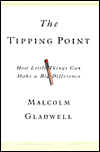
The Tipping Point
by Malcolm Gladwell
How does fashion trends emerge, opinions and behaviors change across society? Gladwell suggests it is analogous to epidemics. Small change spread from person to person, until it reaches a tipping point and all of a sudden ends up with big effect.
This book is wildly popular. It is also highly overrated.
It starts off with a lot of excitement. His theory hold a lot of promises and his stories are captivating. But beneath the exuberance my critical mind started to ask, "can this be true?" Further reading failed to bring forward any strong evidence. Instead the same theme grows increasing tired and the stories get more far fetched. Until it got to some absurd idea like the 'rule of 150'. Which basically says the most effective human group size is around 150, a magic number hardwired in our brain during the evolution process. It would be hard pressed to find any empirical evidence to support this. Astute reader might even notice this actually contradict with the Connectors chapter, where his studies shown the number of connects among any group of people varies greatly from very low to very high. All the same he devoted an entire chapter to this 'discovery' and went about this as enthusiastically as anything else.
Our human society is complex. It is often impossible to attribute any event to a simple cause. So when he reduce complex social phenomenon into a single cause, a lot must be missing from his interpretation. Just what does he say about the dramatic drop of crimes rate in New York subway? "Clean up the graffiti and all of a sudden people who would otherwise commit crimes suddenly don't" Magic solution? Or hasty conclusion?
Gladwell's talent is really in writing and journalism rather than sociology and science. There is a lot of excitement, big surprises, big discoveries, big theories but ultimately with weak scientific basis. Sounds familiar? This is sociology done in the style of popular psychology.
2006.03.01 - comments
